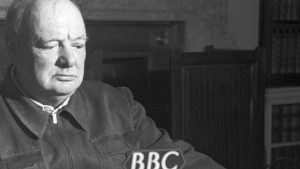
Finest Hour 160
Curiosities – Peter Churchill: What’s in a Name?

Winston Churchill, Parliament Square, London © Sue Lowry & Magellan PR
March 18, 2015
Finest Hour 160, Autumn 2013
Page 56
By Madelin Terrazas
During the Second World War, Peter Morland Churchill, and his colleague in the Special Operations Executive (SOE), Odette Sansom, put his name to use with panache.
Odette Sansom became part of Britain’s clandestine war effort in 1942, after mistakenly addressing a letter to the War Office rather than the Admiralty. She was responding to an Admiralty plea for information on France, to help with raids and the eventual reinvasion of the continent. Enclosing some photographs of the country, she wrote that she was French and knew Boulogne. The War Office sent her material to SOE, and she was duly recruited as an agent.

2024 International Churchill Conference
After completing training, Odette (codename “Lise”) travelled in a small fishing boat to Cassis, where she met the local SOE organiser, Peter Churchill (code-name “Raoul”). Odette’s original mission was to cross Vichy France, joining a resistance group in Burgundy. But when Vichy was occupied by the Germans on 11 November 1942, she remained Peter’s courier in Cannes and later in St. Jorioz, near Annecy, in eastern France near the Swiss border.
Peter and Odette were captured by the Gestapo in 1943. A 1947 letter in the Churchill Archives Centre, sent to Churchill by the couple, explains how they decided to use the Churchill name in order to save themselves.
Able to communicate briefly during their “cell-studded” journey to Fresnes Prison south of Paris, Odette and Peter decided to pretend to be married. This did not have any special effect: arriving at Fresnes, they were placed in separate solitary confinement. But according to Peter, the Gestapo agent who had captured them was convinced that Peter was Winston Churchill’s nephew—and proposed that he be exchanged for Rudolf Hess! (Since his surprise flight to Scotland on 10 May 1941, Hess had been a “guest of His Majesty.”)
Peter denied any relationship to the PM, but Odette’s insistence on it, plus Peter’s refusal to give his home address, convinced the Gestapo it was true. So both were kept as hostages, rather than simply being shot as British agents.
Peter was sent to Berlin and then north to Sachsenhausen concentration camp, in February 1944. In April 1945 he was transferred to Flossenberg and then to Dachau, where he was liberated by the Americans at the end of the war.
In May 1944 Odette was sent to Ravensbrück concentration camp, also north of Berlin. On the way she was interviewed by a Berlin newspaper reporter who told her several members of the Churchill family were already in German custody, and that the entire family would be in Berlin soon. She replied saucily: “When Winston Churchill arrives in Berlin, it will not be in quite the way you expect.”
As the U.S. Army was advancing towards Ravensbrück, the camp commandant, Fritz Suhren, took Odette to the nearest body of troops and told them that she was a relative of Churchill’s, hoping his action would save his own skin. At the Nuremberg trials, Odette’s evidence against Suhren’s operations at the prison camp helped to convict him, and he was hanged in 1950.
Letters at the Churchill Archives Centre reveal that in the autumn of 1944 General Redman, deputy commander of the French Forces of the Interior, contacted Downing Street to ask whether Peter Churchill was indeed a relation. Private Secretary Jock Colville replied that if Peter was a relation he was a very distant one. (In his 1947 letter to WSC, Peter would estimate that they were 62nd cousins.)
In 1946, Odette became the first woman to be awarded the George Cross. She was also awarded an MBE in 1945 and, in 1950, a Chevalier de la Légion d’ Honneur for her contribution to the French resistance. Peter and Odette did indeed marry in 1947, the day after they sent the letter to Winston, but they divorced in 1955. Both remarried in 1956, Odette becoming Mrs. Odette Marie Céline Hallowes. Peter died in 1972, Odette in 1995.
References
Correspondence, WSC and Peter and Odette (1947), Churchill Archives Centre, Churchill Papers, CHUR 2/147/135-37.
Correspondence, General Redman and WSC’s private office, Churchill Papers, CHAR 20/142B/155-57.
Peter Churchill’s Special Operation Executive personnel file, opened 2003, National Archives, Records of Special Operations Executive, HS 9/314 (http://xrl.us/bnwo3j).
Odette, by Jerrard Tickell (London: Chapman & Hall, 1950, republished 2007), was adapted to film by Herbert Wilcox. Peter wrote several books about his wartime experiences, including Of Their Own Choice (1952), Duel of Wits (1953), The Spirit of the Cage (1954) and By Moonlight (1958).
Online sources: Odette biography, Elmbridge Museum: http://xrl.us/bnwo4n. Peter Churchill biographies, http://xrl.us/bnwo5d and http://xrl.us/bnwo5s. Redman biography, http://xrl.us/bnwo5h/.
Subscribe
WANT MORE?
Get the Churchill Bulletin delivered to your inbox once a month.


